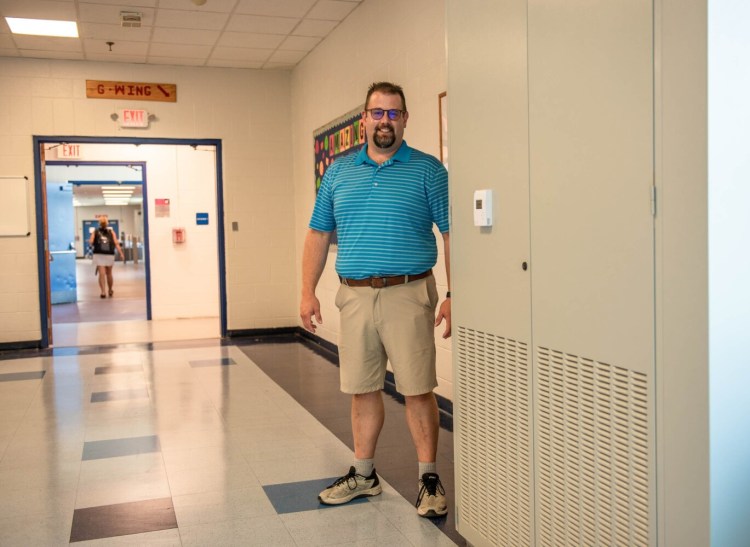LEWISTON — The school district’s priorities for spending federal coronavirus relief funds are health and safety, remedial support for students, and technology support, according to online documents.
The district is set to receive a total of more than $44 million in federal grants, the largest amount among Maine school districts.
The money must be used for response to and recovery from COVID-19.
The first round of funding, about $11.7 million for Lewiston, began in March 2020 and expired June 30, 2021.
It included:
- Day programming grant: $205,752.
- Adult education grant: $82,338.
- District 1: $5.5 million.
- District 2: $5.8 million.
The money was used for personal protective equipment, masks, hand sanitizer, computer devices and internet connections for remote instruction, cleaning supplies, ventilation upgrades and outdoor classroom shelters, among other things related to COVID-19.
The district has been awarded another $31.9 million in Elementary and Secondary School Emergency Relief Funds, or ESSER, which comes in three separate grants.
Part of the first ESSER grant, which totals about $2.2 million, was used for the above items, while about $281,000 was used to help reduce the local tax impact in the 2021-22 budget. About $1.5 million remains, Assistant Superintendent Karen Paquette said Tuesday.
That money can be used through Sept. 30, 2022, according to a presentation to the School Committee on Aug. 2.
Jennifer Darigan, the district’s federal program coordinator, told the committee that the second ESSER grant of $9 million can be used through Sept. 30, 2023. The third, $20.5 million, will be available through Sept. 30, 2024.
The two larger ESSER grants “have been in the planning stage for many months,” Darigan said. “Lewiston is taking every opportunity to apply for funds.”
While the school district has been allocated the three ESSER grants, its application for how it will spend the final two grants has not been given final approval by the state, Paquette said.
The district also expects to receive about $600,000 to enhance its homelessness program, Darigan said. The money will be used to “bring more services to kids and more support for our schools,” she said. “It’s unlike what we’ve ever received before.”
Under its plan, the ESSER funds will be used for further ventilation upgrades at Lewiston High School, Lewiston Middle School and McMahon Elementary School, the Longley building and other district buildings, Darigan said.
“We need upgrades to meet air quality standards,” she said.
The money also will be used to address learning loss among the district’s 5,000 students, many of whom did not fully engage in remote instruction during the pandemic.
The district must spend 20% of the ESSER funds on remedial support to help students get back on track meeting academic standards.
“We have already gone above and beyond that,” Darigan said.
She said 42 academic and social-emotional interventionists have been added to district staff.
Attendance and truancy also will be a focus for the district, she said. Attendance was down 7% from 2019-20 to 2020-21, she said.
Other remedial spending will include:
- Staff and materials for summer programs in 2021, 2022 and 2023.
- Staff and materials for after-school programming during 2021-22 and 2022-2023 school years.
- Two additional building subs, in every school, every day for the entire school year 2021-2022.
- Student instructional supplies to ensure students have all necessary materials to participate in learning during hybrid/remote periods.
- Learning platforms to structure learning expectations and provide resources for students to access as part of their work toward attaining grade-level standards.
- Professional learning opportunities to build educator capacity.
Health and safety spending includes:
- Cleaning materials to meet enhanced sanitation requirements and additional personal protective equipment as needed.
Storage for personal protective equipment and excess furniture removed to accommodate smaller class sizes and social distancing. - Upgrades and/or accommodations to modular classrooms and other potential teaching/learning spaces to expand learning spaces.
- Providing off-duty pay for staff to engage in social-emotional learning days.
- Continuation of the Panorama student survey, a survey instrument that elevates students’ voice on school climate, teaching and learning, relationships and belonging, and provides data for teacher, school and district decision-making related to supporting student emotional and school engagement needs.
Technology support spending includes:
- Laptops, tablets, document cameras, TVs for synchronous instruction with staff and students in remote/hybrid settings, projectors, computer monitors, etc.
- Improvements to tech infrastructure throughout the district to replace existing unsupported servers to improve bandwidth and ensure continued reliability and performance because remote learning has brought on a need for more bandwidth for users.
- Additional instructional materials to support remote and hybrid learning.
- License fees for Seesaw, a comprehensive learning management system for prekindergarten through grade 3 to assist teachers in structuring lesson content for students to access in remote settings.
- License fees for TalkingPoints, a two-way multilingual family engagement platform helping teachers and families to stay connected via text message.
Lewiston schools are set to fully reopen Sept. 1. All students are expected to attend full-time in-person classes. Remote instruction will not be offered because staffing levels cannot accommodate it. However, schools could close if infection rates get too high, officials say.
Send questions/comments to the editors.



Comments are no longer available on this story